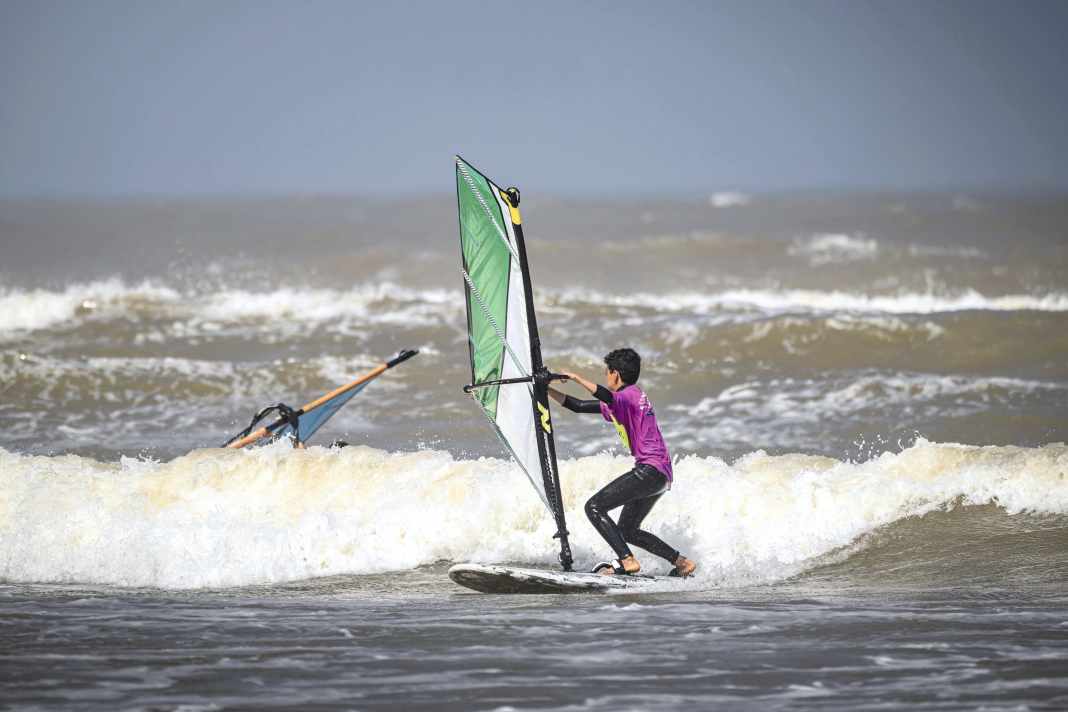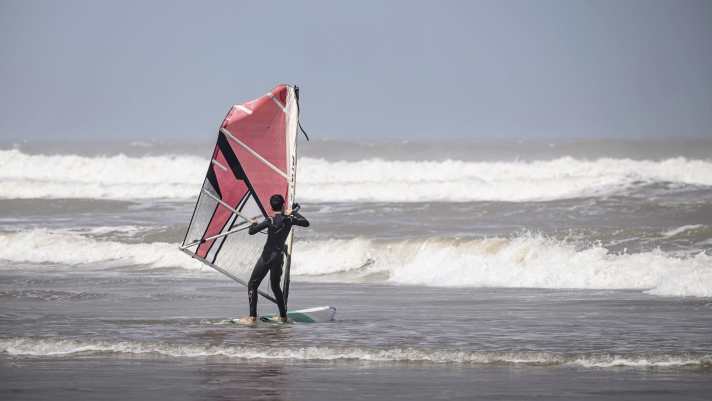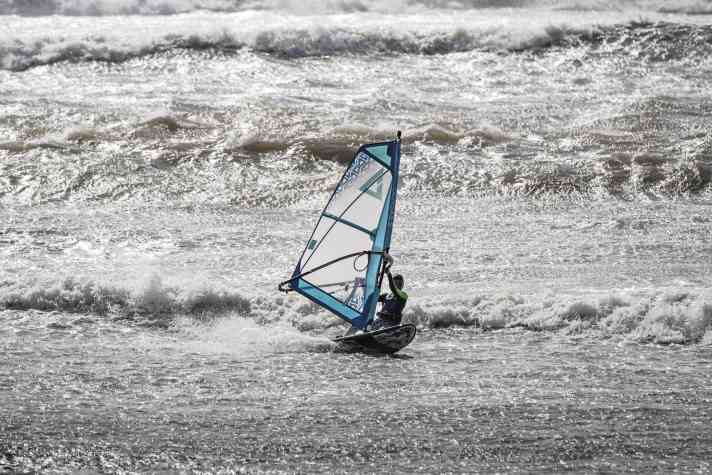





Moulay Bouzerktoun is more than just a place on the map - it is a place where wind, waves and unpredictability meet. Located just 25 kilometres north of Essaouira, the small fishing village has long since made a name for itself on the international windsurfing scene. Here, the trade wind often blows across the Atlantic with full force, creating clean, long waves that are perfect for wave riding and jumping manoeuvres. The spot offers side-onshore to side-offshore conditions, making it challenging but incredibly rewarding and versatile. The wind often arrives lightly in the morning with side-onshore conditions and strengthens throughout the day until it turns to side-offshore in the evening and slowly weakens.
People who surf here are there for the conditions, not the comfort."
The set-up is rough - no palm trees, no luxury, just rocks, water, wind, hardly any Wi-Fi and donkeys as a means of transport. And that's exactly what makes Moulay so special: those who surf here are there for the conditions, not the comfort. The locals live to the rhythm of the wind. Fishermen, campers, windsurfers - and in the middle of it all, the kids from Moulay, who have made the spot their personal training ground. Every day a new attempt, a new wave, a new trick. Moulay is not a place for beginners. But for anyone looking for real windsurfing, it is one of the most magical places in the world.
Who are the kids from Moulay?
Most of them are children and young people from the village itself - or relatives who come to visit from Essaouira. Moulay is almost empty in winter, when many families live in the city. But in summer? That's when Moulay comes alive: Children laugh, sails flutter and the bay is filled with a youthful spirit of discovery. You rarely see the kids from Essaouira - they are often too young to come here themselves. But when they do get the chance to come to Moulay, their eyes sparkle. The local children are there every day. And they are simply part of Moulay's image.

When will you start windsurfing?
As soon as they somehow get to a board! Some are only five or six years old and not even good swimmers yet. Their day? In the morning they sell bread or hats to campers, then, if they are lucky, they go to school, play on the beach or go into the water. If they have material, they go surfing. In the afternoon, it's back on the water.
Between school and surf spot - this is everyday life for the Moulay kids
In Morocco, schooling is compulsory until the age of 16 - even for Moulay's children. However, as is so often the case in the country, the reality is different than on paper. School is usually several kilometres away, the journey to school is long, there is a lack of transport and infrastructure - and when the wind calls, the classroom is quickly forgotten. Many of the children go to school regularly, at least in primary school, but the older they get, the more often windsurfing takes the place of the school desk. Not out of laziness - but out of passion, to gain life experience and sometimes also out of economic necessity. Some help their families in the mornings, sell food to campers and use the afternoons to train on the water. Education here often takes place outside the classroom - when repairing a sail, rigging together or explaining a manoeuvre to the younger ones. And yet: the desire to learn is there. Athletes like Julien Flechet actively promote this approach - with materials, with time and with the belief that sport and education can achieve more together than separately.
What equipment do the kids use on the water?
With anything that somehow works. Broken boards, tattered sails, self-made masts - often made from old fragments or even wood. They don't have any real children's or youth equipment. But every piece counts. Every summer, World Cup riders Julien and Titouan Flechet, together with their sponsor Hotsails, bring used equipment for the kids: small boards, masts, booms, sails. "They come in the morning, rig up, surf all day, rig down and bring the stuff back," says Julien. "And they don't just learn windsurfing, they also learn responsibility." Windsurfing tourists also often leave their broken equipment in Moulay. A torn window is no problem for the kids. The sail is cut to a suitable size and is then ready for use again. It is not uncommon to see older sail models from professionals, such as Florian Jung, who has spent a lot of time in Moulay in the past.
Windsurfing is a real prospect for the future for some of the Moulay kids."
Boujmaa Guilloul is the local hero for the kids
For many of them, windsurfing is more than just fun - it could be a real prospect for the future. Some have even started to work in Dakhla their instructor licence. They then work there as windsurfing or kitesurfing instructors and turn their passion into a profession. And of course they are also motivated by tourism: they want to show what they can do, prove themselves - maybe even be discovered. And they all have a role model in mind: Boujmaa Guilloul, the local hero from Moulay, who has made it to the top of the world. But the annual Moulay Wave Classic (end of April/beginning of May) is a highlight for the Local Kids. They know their spot like no other and spend a year preparing to show the world what talent they have. But the most important thing for the kids is to have fun in the water together - every day if possible.

What makes them so special?
The kids start with nothing. No material of their own, no neos, no sails. But they tinker, improvise - and don't give up. "Anyone who visits Moulay in the summer knows the picture: ten kids with half-broken sails, practising jumps, learning water starts, jibing and conveying a pure passion. Some 6-year-olds are already honing their loops, jumping goiters and sharing the spot with friends and windsurfing tourists," says Julien Flechet. You can't help but wonder: what could these kids achieve if they had the right equipment? What remains is definitely hope. A place like Moulay Bouzerktoun shows that great passion doesn't come from luxury, but from inner fire. And these kids have it in them - day after day, wave after wave. Once you've seen them, you won't forget them.
Some 6-year-old children are already working on loops or jumping goiters."
Helping with old material
Many of the children in Moulay surf with patched-up or completely unsuitable equipment: broken boards, cut sails, booms without grip. Some use homemade masts made of wood - and many don't even have a harness, which makes surfing in the strong wind extremely strenuous. If you have used windsurfing equipment that is no longer being used - whether sails, masts, boards, booms, harnesses or wetsuits - then you can do something really useful with it. Professional surfer Julien Flechet, a regular guest at Moulay, collects equipment in Europe every year together with his brother Titouan and brings it directly to the kids. There it is used intensively and appreciated - not as a luxury, but as a real opportunity. Simply get in touch by e-mail if you would like to help: flechetjulien@gmail.com

